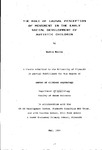THE ROLE OF CAUSAL PERCEPTION OF MOVEMENT IN THE EARLY SOCIAL DEVELOPMENT OF AUTISTIC CHILDREN
| dc.contributor.author | Morris, Martin | |
| dc.contributor.other | School of Psychology | en_US |
| dc.date.accessioned | 2013-11-04T11:16:25Z | |
| dc.date.available | 2013-11-04T11:16:25Z | |
| dc.date.issued | 1995 | |
| dc.identifier | NOT AVAILABLE | en_US |
| dc.identifier.uri | http://hdl.handle.net/10026.1/2558 | |
| dc.description.abstract |
Autistic children often lack social behaviours which are normally present by 8-12 months (Klin et al, 1992; Mundy et al, 1986), although current 'top down' theories about autism hypothesise later-developing conceptual difficulties in social cognition. Research indicates that there are abnormal 'bottom up' perceptual processes in autism (Moore, Hobson & Lee, 1995). Processing of unexpected dynamic visual information may occur to a diminished extent (Courchesne, 1987), whilst in normal infancy, causal perception of the movements of animate. and inanimate objects is likely to be important for social cognition and affective relationships (Shultz, 1989; Premack & Dasser, 1990). It has been suggested that autistic children have difficulties with the unpredictable nature of perceived social information (Moody & Sigman, 1989b; Dawson & Lewy, 1989). On the basis of such previous research, it was proposed that the early social abnormalities of autistic children are a result -of them tending not to notice, or process further, brief dynamic visual information about events unless these follow simple predictable patterns. To test this hypothesis, seven young autistic and seven developmentally delayed children, matched pairwise for verbal comprehension, were initially habituated to two computer-generated displays, of a cartoon-like 'boy' (Runner) running up to a 'wall' and back, and of a 'ball' moving towards the wall and apparently re-bounding back. Visual habituation was reliable and due to information encoding. The autistic children looked relatively less at the Runner habituation display, perhaps due to relatively diminished processing of animate dynamic information. After habituation criterion was reached, a time delay was introduced prolonging contact with the wall, so that the Ball display became 'impossible' whereas the Runner remained 'possible'. As predicted, recovery of visual fixation indicated that the delay was discriminated, and the autistic children recovered relatively less to the novel Ball display compared with the developmentally delayed children. The autistic children may not have perceived the anomaly in the novel 'impossible' Ball event. They either may have had a general expectation for inanimate objects to move independently, or a tendency not to notice altered significance in a repetitive visual event. However, the group differences could also have been due to the autistic children tending not to have real life expectations of cartoon images. Consistent with the hypothesis, the scores of all 14 children both for pre-11 month social behaviours and for joint attention, were associated with relative recovery for the novel Ball display. As predicted from previous research, the autistic children engaged infrequently in these social behaviours. It is proposed that how children perceive the dynamic animate and inanimate world affects how they develop socially during their first year of life. Relevant areas for future research and implications for early interventions are discussed. | en_US |
| dc.description.sponsorship | Child Development Centre, Plymouth Hospitals NHS Trust, Downham School, Mill Ford School & South Trelawney Primary School, Plymouth | en_US |
| dc.language.iso | en | en_US |
| dc.publisher | University of Plymouth | en_US |
| dc.title | THE ROLE OF CAUSAL PERCEPTION OF MOVEMENT IN THE EARLY SOCIAL DEVELOPMENT OF AUTISTIC CHILDREN | en_US |
| dc.type | Thesis | |
| plymouth.version | Full version: final and full version as approved by the examiners at the time of the award of your degree | en_US |
| dc.identifier.doi | http://dx.doi.org/10.24382/1460 | |
| dc.identifier.doi | http://dx.doi.org/10.24382/1460 |
Files in this item
This item appears in the following Collection(s)
-
01 Research Theses Main Collection
Research Theses Main


